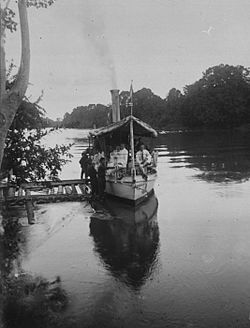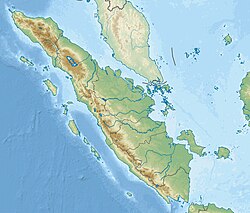Top Qs
Timeline
Chat
Perspective
Tulang Bawang River
River in Lampung, Indonesia From Wikipedia, the free encyclopedia
Remove ads
The Tulang Bawang River (Lampungnese: Way Tulang Bawang) is a river which mostly flows in Lampung, Indonesia.[3] The river lends its name to the Tulang Bawang Regency, where it reaches the Java Sea and the West Tulang Bawang Regency. It also flows across the capital of the regency at Menggala.[4]
One of the largest rivers in the province, it is primarily utilized by locals as a source of irrigation with little use as a waterway.[5]
Remove ads
History
Around the 1750s, the Dutch East India Company (VOC) competed with the British Empire and the more local Palembangese for influence in Lampung, particularly in the pepper trade. Initially they were seen as less desirable to the locals of Tulang Bawang due to their tendency to avoid local conflicts. In 1751 a Dutch post was assaulted and captured by a local prince.[6]
It was not until the mid-1800s when the Dutch East Indies managed to subjugate the locals and established formal administration over the banks. At the turn of the twentieth century, the banks of Tulang Bawang and its tributaries were settled by about 30,000 people, in comparison to the relatively unpopulated regions further away from the rivers. They were mostly inland Abung people living in indigenous houses.[7]
Remove ads
Geography
The river flows in the southeast area of Sumatra with predominantly tropical rainforest climate (designated as Af in the Köppen-Geiger climate classification).[8] The annual average temperature in the area is 25 °C. The warmest month is September, when the average temperature is around 28 °C, and the coldest is January, at 22 °C.[9] The average annual rainfall is 3248 mm. The wettest month is December, with an average of 547 mm rainfall, and the driest is September, with 40 mm rainfall.[10]
Remove ads
See also
Notes and references
Wikiwand - on
Seamless Wikipedia browsing. On steroids.
Remove ads



